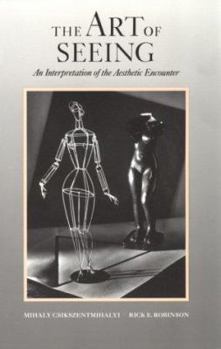The Art of Seeing: An Interpretation of the Aesthetic Encounter
Select Format
Select Condition 
Book Overview
What is the nature of the aesthetic experience? Is it the same for everyone? It is possible to facilitate its occurrence? This book focuses on the psychology of the aesthetic experience and on the perception and understanding of art, suggesting ways to raise levels of visual literacy and enhance artistic enjoyment. The findings will be of importance not only to museum professionals and art educators, but also to psychologists and those interested...
Format:Paperback
Language:English
ISBN:0892361565
ISBN13:9780892361564
Release Date:March 1991
Publisher:Oxford University Press, USA
Length:224 Pages
Weight:0.10 lbs.
Dimensions:0.6" x 6.0" x 8.9"
Related Subjects
Aesthetics Conceptual Education & Reference Other Media Philosophy Politics & Social SciencesCustomer Reviews
2 ratings
A Liberal Arts Must-Read
Published by Thriftbooks.com User , 16 years ago
This extraordinary book is, I believe, under-read and under-utilized. Readers might do best to first read one of Dr. Czikszentmihaly's ("chick-sent-me-high")easier works, such as one of his books on flow experience. Flow: The Psychology of Optimal Experience would be my recommendation here. Once the concept of flow has been grasped, reading The Art of Seeing will take reader to an entirely new level of both theoretical and practical understanding of human happiness, contentment,enjoyment, etc. I would caution that the reader, if he or she is like me, must be willing to study and re-study this book's first 2 or 3 chapters, as these pages lay essential groundwork. However, once these well-written but nonetheless difficult pages are digested, the remainder of the book reads smoothly and pleasurably. I have spent years trying to understand for myself why certain objects, possessions, places, and experiences have held an almost magical quality for me. Similarly, I've tried to understand why certain others have disappointed. Like most other people who are drawn to performing such introspection, I searched for a template or schematic by which I could more easily and practically pursue enjoyment in daily activities as well as my more significant, anticipated experiences. Feng shui seemed vacuous and, frankly, somewhat maudlin. Psychological and psychoanalytic approaches were forced fits. By contrast, The Art of Seeing presented, in unbiased fashion, a very intellectual yet immensely useable alternative that, within days, I could apply in many situations. For instance,I found that those frustrating and confounding puzzlers that shouldn't be such a big deal but nonetheless are ("Why do I like this car in this color but not in that color?....My wife would like to get this painting, but it actually sort of annoys me...How can I make the backyard something that everyone else will enjoy it as much as I do?...The builder needs us to make a decision on the cabinets today, but we both feel unsure...)could be approached, analyzed, and resolved with much greater ease through application of this book's principles. The larger, more substantial parts of who I am (enjoying oils much more than watercolors, favoring rock and country over classical music despite all attempts to the contrary, enjoying hunting and hiking in forests more than in mountains, etc) also could be studied and understood by the same method. I enjoyed my liberal arts education very much, but many of my classmates and colleagues did not. Had they been exposed to this book, thereby receiving the opportunity to truly understand their likes and dislikes, their passionate loves and hates, I believe many of them would have fuller, less materialistic lives today.
Insightful study of visual art and the aesthetic experience
Published by Thriftbooks.com User , 20 years ago
"The Art of Seeing" is a study of the aesthetic experience through the lens of Csikszentmihalyi's "flow" theory of experiences which, somewhat ironically, have been given the technical description of autotelic experiences. The text begins with a discussion of some philosophy and psychology of art that leads into the development of a conceptual model of the aesthetic experience built around the four dimensions of perception, emotion, intellectual engagement, and communication. The bulk of the work consists of the quantitative analysis and interpretation of interviews with museum professionals. The authors further discuss the model in the context of the data, and make recommendations on how museums can better serve their mission.Although the book seems aimed at museums (the study was done at the behest of the Getty and published by the Getty Press), I found the "flow" model of the aesthetic experience to be quite enlightening, and useful in increasing the quality of my own aesthetic encounters.




